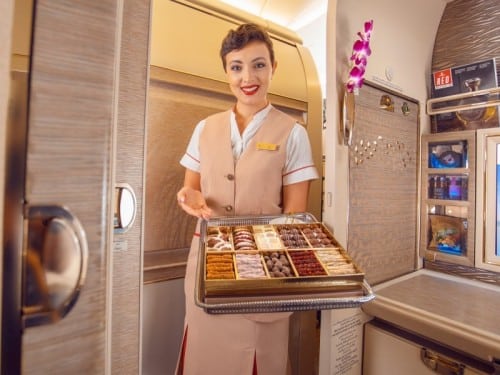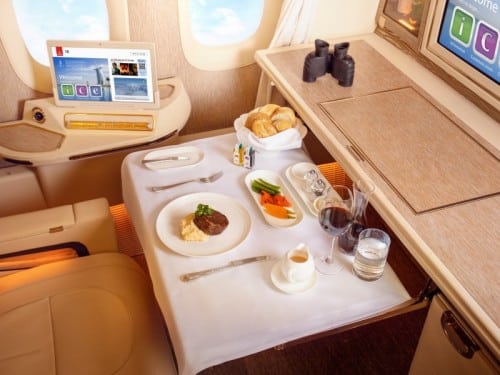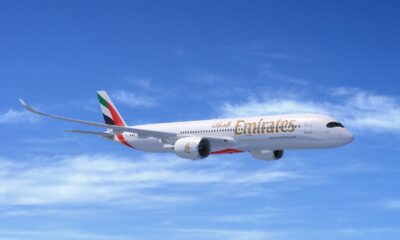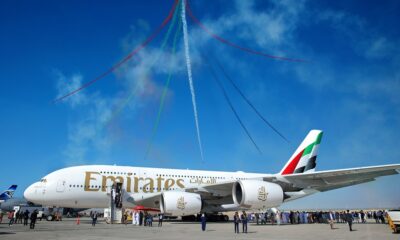Airlines
Emirates invests over US$ 2 billion to take its on-board customer experience to new heights
Emirates investing more than US$ 2 billion to improve the in-flight passenger experience. This includes a massive programme to retrofit more than 120 aircraft with the newest interiors
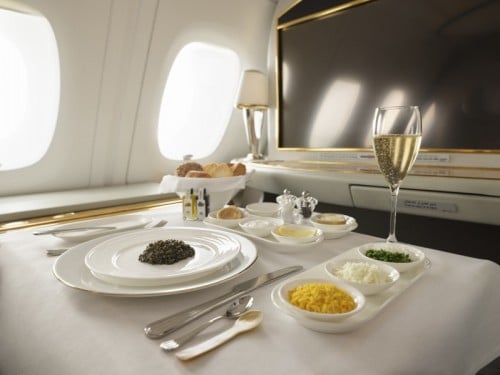
Emirates, which takes pride in its brand promise to “Fly Better,” is investing more than US$ 2 billion to improve the in-flight passenger experience. This includes a massive programme to retrofit more than 120 aircraft with the newest interiors and a variety of other service improvements starting in all cabins in 2022.
New Inspirations, New Menus: An award-winning team of chefs, a world-class catering team and a wide variety of suppliers have been assembled to design and deliver the best fine dining experience in the sky. New menus will be served on select Emirates routes in First Class, featuring dishes such as pan-fried salmon trout with moqueca sauce and creole rice, roasted duck breast with orange thyme jus, steamed broccolini and fondant potatoes. New menus will also be introduced to Business and Economy on the 1st of September.
Purposefully Vegan Choices: Emirates’ new vegan menu is carefully curated to cater to the growing numbers of customers pursuing this thoughtful lifestyle. Vegans, or anyone interested in a delicious and healthy plant-based meal, will enjoy handcrafted gourmet dishes such as pan-roasted king oyster mushrooms, flavorsome jackfruit biryani, and sliced kohlrabi garnished with burnt orange. Desserts are a decadent affair with choices of chocolate truffle cake with hazelnut, pistachio, and gold leaf, or green grape tart adorned with candied rose petals, and vanilla custard, and berry compote glistening with yuzu pearls.
The Champagne and Caviar Experience: Emirates’ First Class experience, always a benchmark for service excellence, has been upped a notch in 2022. Customers can now savour unlimited portions of Persian caviar as part of the ‘dine on demand’ service, with an exquisite pairing of the world-renowned Dom Perignon vintage champagne. Emirates is the only airline with an exclusive agreement to offer the luxury brand on-board.
Cinema in the Sky: First Class customers can create a memorable movie moment on-board by ordering cinema snacks as they enjoy the 5,000 channels on Emirates’ ice inflight entertainment system. The cinema snack menu includes moreish classics such as lobster rolls, juicy sliders, edamame, and salted popcorn, and can be ordered on demand. All passengers can also curate their own ice experience before their flight, simply by browsing and pre-selecting movies or TV shows on the Emirates app, which can then be synced to ice the moment they board, maximising the seamless travel experience.
Farm to Fork – Sustainable Supply Chain: Emirates’ customers departing on flights from Dubai can begin crunching on fresh greens harvested from Bustanica, the world’s largest vertical farm and newly-opened US$40 million joint venture investment through Emirates Flight Catering. Emirates is continuing to invest in sustainable operations and supply chains, seeking local food suppliers and farms wherever possible to serve the freshest produce on board.
Specialised Hospitality Training for Cabin Crew: Emirates has partnered with Ecole hôtelière de Lausanne, one of the world’s top hospitality management schools, to craft the Emirates Hospitality strategy and encourage inspiring customer experiences. Emirates Cabin Crew have already begun engaging in intensive training programmed focused on delivering the four service pillars: Excellence, Attentiveness, Innovation and Passion.
Upgraded Cabin Interiors in all Classes: The most significant investment is an extensive and record-breaking refurbishment of the aircraft fleet interiors, where cabins will be retrofitted with new or reupholstered seats, new panelling, flooring and other cabin features. Benefitting all Emirates passengers, every cabin class will be refreshed and new Premium Economy cabins installed.

Airlines
A software error caused grounding the entire airline fleet

On Wednesday, the U.S. Federal Aviation Administration (FAA) issued a ground stop advisory for all Alaska Airlines and subcarrier flights due to a software issue, disrupting travel plans for passengers.
The FAA directive, which prohibited the departure of Alaska Airlines mainline and subcarrier flights, was implemented as a precautionary measure following the detection of the software problem. The ground stop was initiated after Alaska Airlines encountered difficulties during a system upgrade related to the calculation of weight and balance for their flights.
As a result, the airline opted for a temporary suspension of all its operations to address the issue and ensure passenger safety. Alaska Airlines promptly issued a statement acknowledging the incident and expressing their commitment to resolving the matter swiftly. “This morning we experienced an issue while performing an upgrade to the system that calculates our weight and balance.
Out of an abundance of caution, we requested a ground stop for all Alaska and Horizon flights, which was instituted at approximately 7:30 a.m. PT,” the statement read. Passengers affected by the disruption voiced their concerns on social media platforms, prompting Alaska Airlines to reassure them of their efforts to minimize the inconvenience and expedite the resumption of flights.
Following approximately an hour-long interruption, the FAA lifted the ground stop order, allowing Alaska Airlines and its subcarriers to resume normal operations. However, it was clarified that SkyWest, which provides regional service for Alaska Airlines and other carriers, was exempt from the ground stop and continued its flights unaffected.
Aerospace
Which is bigger 777x or 787 aircraft ?

The 777X is a new series of the Boeing 777 family and is designed to be larger and more efficient than its predecessor. It features two variants: the 777-8 and the 777-9, being the larger of the two.
The Boeing 777X emerges as the larger sibling within the Boeing family, representing a significant leap forward in both size and efficiency. Comprising two variants, the 777-8 and the 777-9, the latter takes the crown as the larger of the two. With its expansive fuselage and impressive wingspan, the 777X is tailored for long-range journeys and boasts a substantial passenger capacity.
On the other hand, the Boeing 787, affectionately known as the Dreamliner, occupies a niche in the market as a smaller yet formidable aircraft designed for medium to long-range flights. Its distinguishing feature lies in its composite fuselage, a technological marvel that renders it lighter and more fuel-efficient compared to conventional aluminum counterparts. The Boeing 777X is larger than the Boeing 787 aircraft.
When it comes to passenger capacity, the 777-9 reigns supreme, typically accommodating a sizeable contingent of 400-425 passengers in its standard configuration. In contrast, the 787, with its more modest dimensions, typically carries between 240-290 passengers, depending on the variant and layout.
One of the remarkable innovations introduced with the 777X is its folding wingtips, a feature designed to address the logistical challenges of accommodating such a large aircraft in conventional airport gates. These folding wingtips enable the 777X to retract its wings, allowing it to fit into gates designed for smaller aircraft while still reaping the benefits of an extended wingspan during flight, thereby enhancing fuel efficiency and operational flexibility
Airlines
Why Don’t Airplanes Fly Over the Pacific Ocean?

Flights do indeed fly over the Pacific Ocean, but the routes they take are often determined by factors such as airline policies, air traffic control decisions, and weather conditions. The Pacific Ocean is one of the largest bodies of water on Earth, and it’s regularly crossed by numerous flights traveling between North America, Asia, Australia, and other destinations.
However, some specific routes might avoid flying directly over certain parts of the Pacific Ocean for various reasons. For example:
- Safety and emergency considerations: While modern aircraft are equipped with advanced safety features, airlines, and pilots may prefer routes that keep them closer to potential diversion airports or within range of search and rescue facilities in case of emergencies.
- Air traffic control restrictions: Airspace management authorities may impose certain restrictions or preferred routes for managing air traffic efficiently. These restrictions could be based on factors such as military operations, airspace congestion, or diplomatic considerations.
- Weather conditions: Pilots and airlines consider weather patterns when planning routes. While the Pacific Ocean generally experiences fewer weather-related disruptions compared to other regions, factors like turbulence, thunderstorms, or tropical cyclones can influence route selection.
- Managing Cost Factors: In route planning, airlines have to take fuel prices, maintenance costs, crew charges, and other operating costs into account. Direct routes over the Pacific Ocean may be more cost-effective for shorter distances, but they may also necessitate extra safety precautions, including carrying more fuel for longer overwater operations.
- Remote Locations and Navigational Challenges: The Pacific Ocean’s vastness poses navigational issues, particularly for aircraft operating over isolated regions with few ground-based navigational aids. For precise positioning and route direction, pilots must mostly rely on satellite-based technology and onboard navigation systems, which may necessitate additional training and equipment purchases.
- Lack of Suitable Landing Options in the Pacific Ocean: Unlike regions with dense air traffic and numerous airports, the Pacific Ocean has vast stretches of open water with few suitable landing options in case of emergencies. While long-range aircraft are equipped with safety features like life rafts and emergency locator transmitters, the lack of nearby airports can increase the time it takes for rescue and recovery operations to reach distressed aircraft, posing additional risks to passengers and crew. Therefore, flight routes may be planned to ensure proximity to potential diversion airports or alternate landing sites in case of unforeseen circumstances.

